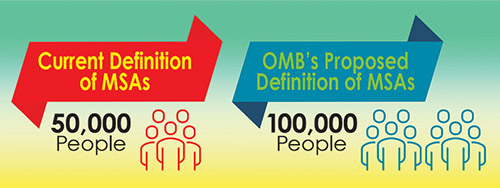Front Line: Changing the Definition of MSAs
Will the proposed redefinition of Metropolitan Statistical Areas and subsequent funding communities receive affect your company’s location decision?
Q3 2021

MSA designations are used to identify cities and surrounding communities linked by social and economic indicators as established by OMB for the purpose of allocating federal funds. Metropolitan and non-metropolitan designations are used by agencies across the federal government to determine eligibility for funding and services.
The OMB proposal to revise the standard could threaten access to vital federal resources for about 150 communities across the country, according to the bipartisan authors of a bill introduced in Congress — the Metropolitan Areas Protection and Standardization Act — to put the proposed changes on “hold.” However, the federal government has not provided a full analysis of which programs use this designation, some critics say. While losing MSA status may not necessarily result in a loss of federal funds, some leaders say there is major uncertainty about the proposal that could result in harmful, unintended consequences.
Why the Change Now?
Jennifer Steinfeld, director of Entrepreneurship and Economic Development for the National League of Cities, says the league has not taken an official position on the proposal. But, with the U.S. still recovering from the pandemic, this would not be a good time to make the change, she says. “Communities are in the middle of a tenuous recovery, and any dramatic changes in how they are treated on the federal level will have a significant financial impact,” she notes. “So, we certainly hope the government will tread carefully.”
Tony Pipa, a senior fellow in the Brookings Institute’s Center for Sustainable Development, told Area Development there are some major, unanswered questions surrounding the proposal to change the MSA standards. “The suggestion to increase the minimum threshold for what defines an MSA is a statistical adjustment that does not seem to have overwhelmingly strong scientific rationale. The committee’s rationale seems to be ‘Since we started using this standard, the population has doubled, so we have to double the standard.’
“That doesn’t give you much to go on for the future and raises a lot of questions. Will you continue to recalibrate this in the future, what are the things that trigger such a recalibration, and what is the scientific basis for this?” Pipa asks.
Bipartisan legislation introduced in Congress would require OMB to provide a public report to Congress estimating the county-level impact and justifying the scientific basis for any proposed change to an existing statistical area standard. “The recommendation didn’t come with that sort of depth of analysis,” Pipa says. Also, there are major policy implications for what locales receive federal funding and how that funding is allocated, he notes. “The OMB thinks the standard should not be part of the funding criteria, but we know it is, in lots of places. Nobody has a good handle on who would be the winners and losers. Will the federal money go to communities that really need it?” For local communities across the U.S., there are also larger questions of identity, Pipa says. “Do these areas think of themselves as agricultural, non-metro, or metro — those questions are out there. How is that perceived in the marketplace? Are economic developers going to look differently at a place that has a population of 70,000 but all of a sudden is no longer a metro area? Are companies going to look at them differently?” Pipa has “heard from a lot of local leaders who are worried about not getting attention because they feel that businesspeople and economic development investors see that MSA designation as a benchmark. Or, they look at that list,” when they are starting to consider sites for projects.
Thinking Things Through
Pipa doesn’t know if changes in the MSA standards will directly impact the incentive packages that communities will be able to offer business and industry. “But, indirectly, they are worried about their ability to be a part of transportation planning…being able to access resources to develop infrastructure. That might impact their ability to make offers. So, they are concerned about the ripple effect,” he notes.
Before OMB makes any change, Pipa would like to see the OMB take the committee recommendation under advisement, and “put a process in place, for example, through the national academies of science to bring together a set of experts who are outside of government, and start to understand the statistical part of it in a much more rigorous way,” he says.
He also contends the agency needs to engage more directly with rural areas, “which — since the 2008 recession — have been struggling in ways that are different from suburban and urban areas. Do the financial analysis and also understand through interaction with rural and metro leaders what the overall impact would really be, so they can make more informed, smarter decisions.”
The bipartisan legislation introduced in Congress would require OMB to provide a public report to Congress estimating the county-level impact and justifying the scientific basis for any proposed change to an existing statistical area standard. The bill, sponsored by Senators Gary Peters (D-MI) and Rob Portman (R-OH), chairman and ranking member of the Homeland Security and Governmental Affairs Committee, would also step up reporting on current uses of statistical area standards and mandate time for public comment before recommending, adopting, or implementing changes. The Metropolitan Areas Protection and Standardization Act is supported by the U.S. Conference of Mayors, the National Rural Health Association, and the National Association of Counties, among others.
Project Announcements
Lupin Expands Coral Springs, Florida, Operations
12/29/2025
KPPC Advanced Chemicals Expands Casa Grande, Arizona, Operations
12/29/2025
Volvo Group Plans Tacoma, Washington, Distribution Operations
12/29/2025
Alnylam Pharmaceuticals Expands Norton, Massachusetts, Operations
12/29/2025
SencorpWhite Plans Hamilton, Ohio, Headquarters-Manufacturing Operations
12/29/2025
Salvagnini America Expands Hamilton, Ohio, Operations
12/28/2025
Most Read
-
The Workforce Bottleneck in America’s Manufacturing Revival
Q4 2025
-
Rethinking Local Governments Through Consolidation and Choice
Q3 2025
-
Lead with Facts, Land the Deal
Q3 2025
-
Tariff Shockwaves Hit the Industrial Sector
Q4 2025
-
Investors Seek Shelter in Food-Focused Real Estate
Q3 2025
-
America’s Aerospace Reboot
Q3 2025
-
The Permit Puzzle and the Path to Groundbreaking
Q3 2025


